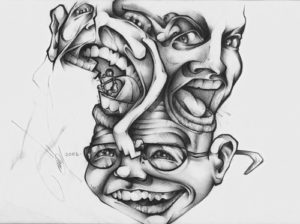MULTIPLE BRAND PERSONALITY DISORDER


Among the many sicknesses that can plague your brand, MBPD tops the list. It’s the one to watch out for. If you have many personalities vying for space within one brand, needless to say, its havoc. Let’s quickly go over some tell tale signs, so you know what remedies you are seeking.
- We are the no. 1 brand in the sector, but own the smallest market share
- We are an international brand, with a presence in only one country
- We are a friendly brand, but with campaigns that are clinical
- We are a leading technology brand, with an archaic website
- We are trendsetters, with not a single new trend to our claim
- We are sophisticated, but our service experience is crude
- We are leaders in innovation, experience, design, marketing and technology
Some brands have even more nuanced symptoms that can be dangerous because they are seeped into the system so deeply, they are hard to recognise and change, and can prove fatal.
I would say this applies mostly to the zones or points of experience and contact.
Discrepancies in voice, language, vocabulary and tonal differences could affect communication platforms such as IVRS, customer representative behaviour standards, website content, social media content etc.
Similarly, public area music, hold music, ads (individual ad stories could and will have specific music associations, but the string of ads themselves cannot be discordant in their musical treatment), YouTube channels and podcasts, cannot be moving violently between genres so diverse, that there is no thread to bind them together.

Brands ought to have ![]() ; many facets, yes, but just one persona that you are known for. If you have too many brands claiming that position, then you’ve either not identified yourself correctly, or you’ve just not done enough to own that persona.
; many facets, yes, but just one persona that you are known for. If you have too many brands claiming that position, then you’ve either not identified yourself correctly, or you’ve just not done enough to own that persona.
Think about it like this. All of us engage in relationships of different kinds. No matter what the degree, term or nature of the relationship, it can’t possibly survive without trust. An inconsistent relationship is better not begun.
Brands are no different. We create various embodiments of a brand, in order to make that all-important connection with our customers. And we’d like them to stay with us. Trust is that binding force. If we are inconsistent and split between our multiple personalities, we have lost that trust. And that’s something hard to regain and one your competition will be quick to beat you to.
It is therefore most imperative that brands build and live one persona.
In the current times of ‘continuous partial attention’ [it is exactly that – when you are only partially attentive, continuously], the smartest and most effective tool is to develop a consistent audio universe around your brand.
I have alluded to how this can be achieved by pointing out the areas of inconsistencies earlier, but for more on how sound can be your answer to unifying your brand’s personality, stay tuned!
Authored by: Aishwarya Natarajan
Sunoh

“Alexa, what’s the weather like in Rome today?”; “Ok, Google, which is the nearest VW service centre in my area?”; “Siri, please send a message to mom and tell her I will call her later”.
If you have heard or used these voice assists, you would know they are becoming part of everyday living. They can help you find things and places, make suggestions, place calls, book your tickets, buy your groceries, tell you stories, play you songs, turn the lights on in your room, book your appointments, remind you to hit the gym! And their capabilities are only expanding.
For marketers and customers, the advent of e-commerce in the 90s, quickly followed by m-commerce, were real game changers.
But we have now moved into an age where voice dominates search and commerce. 20% of mobile searches are through voice and this has led to a boom in voice enabled mobile devices. According to ResearchAndMarkets.com, “the global Far Field Speech and Voice Recognition market accounted for $830.36 million in 2017 and is expected to reach $4950.36 million by 2026. Voice enabled digital assists are no longer the bastion of the mobile phone holders. Hands-free devices like Google Home, Alexa and Home Pod are contributing to an increased time spend on audio enabled consumption and entertainment.
Adding to this trend is an overall surge in music and audio related products and services such as podcasts, audio books and music streaming services.
So in an era of constant thumbing (Instagram, Whatsapp, SnapChat!), short attention spans, instant gratification and need for convenience at our fingertips, the visual medium falls short in catching customer attention.
Here’s where investing in good sound assets can take a brand a long way. If you’ve jumped on the V commerce-entertainment bandwagon, then you might want to consider getting ahead of the curve with intelligently designed audio that supports it. It really depends on where you want to start and how deeply you want to seed the audio into your brand’s DNA. However, before getting into the game, it would serve well for brands to do some basic checks.
- Find your voice If your brand has a well-defined personality, it should consequently have a voice as well. A mismatch in the 2 would be a disaster. Take Bira for example, a leading craft beer in India. The brand is aimed at the millenials, has a fun, quirky personality and a touch of dominance in wanting to own the beer market for the urban youth. It doesn’t take a branding wizard to tell you that a communication strategy or campaign that makes Bira sound like a 40-year-old gent, will do nothing to spur the target into any action. It might even have the opposite effect! Bira has got it spot on though, and have quickly become India’s favourite beer.
- Take stock of existing sound assets This could include existing music or sound across different ‘ear’ points. For example – physical spaces (shared office space, branded audio for conferences, product launches, retail space etc.), digital and mobile platforms (web page opening sounds, transaction sounds, app notifications, ringtones etc.), TV & radio, hold music and social media engagements. Do you have a presence in any or all of these?
- Intensity check You want a cohesive sound that pervades through the brand’s elements, but not one that is aggressively in-your-face all the time. Sound assets should be deployed where they add value (draw attention, make an emotional connection, provide information, or enhance an experience). A quick assessment can help you identify areas that need tuning down or tuning up.

If you have your checklist ticked off, we can dive straight into how beautifully crafted sound/music can augment your offering in the universe of voice search and V commerce.
There is one other thing to bear in mind. As a brand, you are either developing sound assets to be in the game, or simply making yourself accessible in territories that are built around voice.
Let me explain. Going back to brand Bira again, let us assume this non-technology brand doesn’t want to be left behind in the race of voice-enabled everything. What are their options?
- APP – A voice enabled Bira app that extends its identity into food that goes with a pint of Bira – Bira recommended food joints, food stories, trivia on lager etc etc.
- ALERTS – Signature notification alerts from fellow Bira drinkers.
- VOICE COMMANDS – Voice commands that use the word Bira to trigger signature sounds.
In each of the above examples, the brand is creating platforms that use voice.
Alternatively, they need not limit themselves to such options. They can expand their universe by making their presence felt on existing voice enabled platforms, by generating quality content.
- Create interesting branded content around music and link up with digi assists like Alexa or Google Home.
- Create Vlogs (video blogs) and podcasts that incorporate your brand’s sounds.
- Back audio books by young authors on Kindle, so Alexa can read them out to you.
The opportunities are endless. The trick is in keeping your eyes ears open and thinking outside expected behaviour or convention.
So don’t keep those ears covered, because the audio world is not a bubble. It is everything outside it.
* Written without endorsement or knowledge of Bira
* But we will graciously accept a crate of the craft anytime!
Authored by: Aishwarya Natarajan
SUNOH
May 20, 2019
